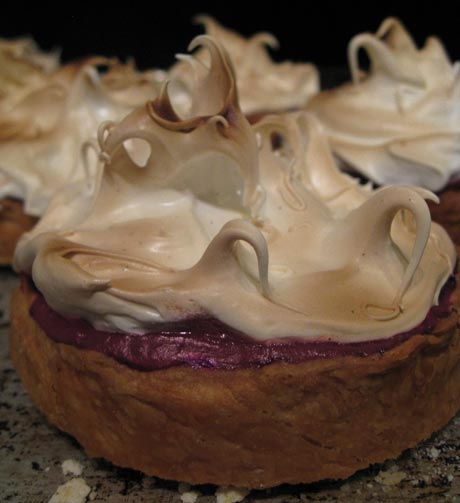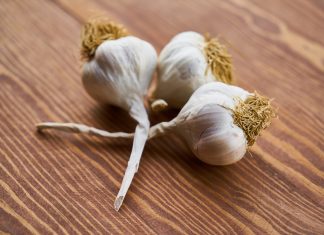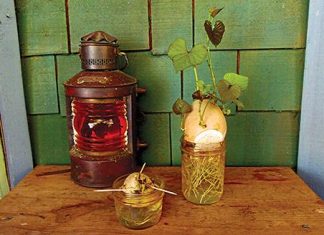| Issue #123 • May/June, 2010 |
Many of us are surrounded by “free” foods we never think of utilizing. Perhaps you look out on your backyard or meadow, and think G-R-A-S-S! But you have a world of wild edibles surrounding you if you just take a moment to look closely.
Foraging is the ancient tradition of gathering what Mother Earth provides for not only nutritionally rich meals, but overall holistic health. Most of you are already well versed in non-traditional foods, but have you ever considered creating wild edible dishes to reduce your grocery bill, or how about to supplement your income?
It’s time to get out a field guide and go hunt up some wild edibles to celebrate spring.
April McGreger is an excellent chef and baker, an entrepreneur, a scientist, and most importantly creatively inclined. As a local food advocate, April cooks in season, and when winter comes around she leans heavily on the goods she’s preserved and the plants she can find in the wild. Originally from Mississippi, April comes from a family of five generations of farmers; her father is a sweet potato farmer on the family’s Mississippi homeplace. After completing her Geology degree, April spent some time chasing volcanoes in Italy, and finally settled in Carrboro, North Carolina where she took up cooking. She calls her journey a full circle venture, her knowledge of the earth itself gives her an intimacy with Mother Earth’s bounty through science and taste.
April worked as a sous chef in local restaurants gaining her acumen for food creation, and finally decided to start her own business. Her Farmer’s Daughter Brand foods are found at the local Farmer’s Market or by special order. (Visit April’s website at www.farmersdaughterbrand.com for more info on where to buy her products.)
“Farmer’s Daughter is a farm-driven artisan food business celebrating the flavors of the South and the soils,” said April. April’s interest in wild edibles grew when she took a class by Will Endres, a native West Virginian who is a nationally recognized expert in the field of herbs. April proceeded to apprentice under Endres, and quickly found a reconnection to the earth, that she calls akin to religion.
For the beginning forager learning to identify wild herbs and edibles, April suggests the following books: A Field Guide to Wild Edibles and A Field Guide to Medicinal Plants and Herbs by Peterson Field Guides (be sure to get the appropriate edition for your region) and The Way of Herbs by Michael Tierra. April also recommends any book by Susun Weed or Euell Gibbons. “Nothing compares to actually going out on a field class hike, or with an experienced forager,” said April, “but you can find excellent information from field guides that will help you learn to forage.”
As an expert forager who lives in an urban environment, April has wild edible “second sight,” but she warns never to eat anything you cannot identify without 100 percent confidence.
April’s main edibles include six easily-found and simple-to-prepare herbs: sassafras, sumac berries, chickweed and cress (April uses these interchangeably), dandelion, and stinging nettle.
Sumac berries
“Some people think the sumac berry is kin to poison sumac, but that’s not the case,” said April. “Sumac berries are abundant in this region, and are easy to store.”
Sumac berries are harvested while dry, and once gathered can last year round. “Sumac berries were used by Native Americans to make ‘pink lemonade’ or sumac tea,” said April. You can make your own lemonade using the berries, which when crushed lend a pink tint to the water.
April’s tour-de-force with the sumac berry has been to create an unbelievably delicious and shocking meringue sumac pie. She laughs and says it is empowering to create foods that change people’s perceptions of wild edibles, and what exactly is the “norm.” Serve at your next family gathering, and be sure to drop your pie’s ingredients after your guests have had a bite.
|
Sumac meringue pie
One pre-baked and cooled 9½-inch pie crust or four 4½-inch tart shells (recipe follows)
Filling:
1¼ cups sugar
6 Tbsp. cornstarch
¼ cup fresh lemon juice
2¼ cups strong sumac tea (recipe follows)
5 egg yolks
¼ tsp. salt, plus a pinch
2 Tbsp. grated lemon zest
4 Tbsp. unsalted butter, cut into
pieces
pinch of salt
For meringue:
7 large egg whites
¾ cup sugar
½ vanilla bean, scraped
pinch of salt
To make the filling, sift together sugar and cornstarch in a medium bowl. Stir in 2¼ cups of sumac tea, and mix until smooth; set aside.
In a nonreactive saucepan, combine lemon juice, 5 egg yolks, and pinch of salt. Set over medium heat, and stir in cornstarch mixture; cook, stirring constantly, until mixture just comes to a boil, about 12-14 minutes. Remove from heat; whisk in the lemon zest and butter. Pour filling into a bowl, and set aside to cool, stirring occasionally.
Pour filling into the baked and cooled pie crust or tart shells. Cover and refrigerate until firm, about one hour.
To make the meringue: Heat broiler. Bring a medium saucepan of water to a simmer. Combine 7 egg whites, ¾ cup sugar, and ¼ teaspoon salt in bowl of an electric mixer. Hold bowl over simmering water; whisk until the mixture is warm and the sugar has dissolved, about 3 minutes. Return bowl to mixer fitted with the whisk attachment, and beat until stiff peaks form. Using an offset spatula, spread each pie with meringue so the filling is covered and the meringue touches the edges of the piecrusts.
Transfer pies to broiler, and lightly brown the meringue, watching constantly, 30 to 45 seconds. Remove from broiler, and place on a wire rack to cool to room temperature before serving.
Basic pie crust
Yields one 9-inch pie shell or four 4½-inch tarts.
1½ cups + 1 Tbsp. all purpose flour
½ tsp. kosher salt
10½ Tbsp. unsalted butter, cut into 1-inch pieces and frozen for 10 minutes (or 8 Tbsp. unsalted butter + 2½ Tbsp. lard)
1/3 cup ice water
Tips on ensuring a flaky pie dough: Work the dough very briefly, making sure some of the butter remains in pinto bean size pieces. When you roll out your dough, you should see some streaks of butter. Make sure that after you form your pie dough you chill it very well and let it rest in the freezer for a half hour before baking. Glass or aluminum pie pans yield the best, crispiest pie crust.
Combine the flour and salt in a mixing bowl. Scatter the butter over the flour, and use a pastry blender, a fork, or two knives to cut the butter into the flour until the mixture forms large crumbs and some of the pieces of butter are still the size of dried pinto beans. Drizzle in the ice water and combine with a fork until the dough begins to come together into a ball but is not completely smooth.
On a lightly-floured work surface, shape the ball into a disc about 1 inch thick and wrap well in plastic wrap. Chill the dough at least 2 hours or overnight before rolling out.
Divide the dough into 4 pieces if making tarts.
Roll out the chilled dough into a circle 1½ inches larger than your pie pan. Line the pan with the dough and trim it with scissors to leave ½ inch overhang of pie dough around the pan. Fold the dough overhang under, and flute or crimp the edge or leave it plain. Refrigerate or freeze the dough until ready to use, or at least 30 minutes before baking. The shells may also be wrapped well and frozen for up to two months at this point. It is not necessary to thaw them before baking.
To blind bake the pie crust: Preheat oven to 400° F. Prick the bottom and sides of your pie dough all over with a fork. Line the pie shell with a sheet of aluminum foil or wax paper. Fill the pie shell up to the top edge with dried beans, rice, or pie weights. Bake shell in middle of oven 10 minutes. Remove paper and rice or beans carefully and bake shell until golden, about 12 minutes more. Cool shell in pie plate on a rack.
Sumac tea
1¾ cups red sumac berries
4 cups water
Place sumac in a medium saucepan and cover with cold water. Bring water to a boil and lower heat to a simmer. Simmer for 15 minutes and shut off heat. Let steep for 30 minutes to 1 hour more. Strain through a fine-meshed strainer, cheesecloth, or coffee filter. Measure out 2¼ cups of sumac tea.
Sassafras
April likes to use the leaves of the sassafras plant as a thickener in her Gumbo z’herbes (or green gumbo). Down in the Gulf South they call it filé and it is the standard thickener. Root beer is also made from the root of the sassafras plant, and April says that her love for this particular herb inspired a dessert out of the ordinary.
|
Sassafras tassies
This recipe is reminiscent of pecan pie but with the unmistakable “root beer” taste of sassafras.
Dough:
½ cup (1 stick) unsalted butter, room temperature
1 3-ounce package cream cheese, room temperature
¼ tsp. salt
1 cup all purpose flour
Filling:
½ cup strong sassafras tea (recipe follows)
½ cup Sucanat or Rapadura, or brown sugar
½ cup good quality honey
2 Tbsp. unsalted butter
2 tsp. all-purpose flour
1/8 tsp. baking powder
2 eggs, beaten
¾ cups of coarsely chopped toasted pecans or walnuts, optional
Whiskey-honey glaze (optional):
2 Tbsp. whiskey
1 Tbsp. honey
To make the shells: Beat butter, cream cheese, and salt in large bowl until blended. Stir in flour (dough will be soft and sticky). Scrape dough onto sheet of plastic wrap. Shape dough into disk. Cover and chill until firm, at least 2 hours or overnight.
Lightly butter a mini-muffin pan. Divide the chilled dough into 24 pieces and press in the bottom and up the sides of the miniature muffin cups, or you may use a regular size muffin tin and divide the dough into 10 pieces. Chill until ready to use.
Preheat oven to 375° F.
To make the filling: In a saucepan combine the sassafras tea and Sucanat or brown sugar and bring to a boil to dissolve sugar. Off heat, add the honey, butter, and vanilla and cool slightly.
In a medium mixing bowl, combine the flour and baking powder. Stir in the sassafras mixture. Whisk in the eggs.
Divide the chopped pecans or walnuts among the dough-lined muffin cups. Spoon 2 to 3 teaspoons of sassafras filling into each shell (filling to the top of the pastry). Bake on the lower shelf of the oven for 15-20 minutes, until lightly browned. For larger muffin tins, add another 5 minutes to baking time. Remove from the oven and immediately brush with the whiskey honey glaze. Cool for five minutes before removing from pans. Then cool completely.
Makes 24 tassies.
Sassafras tea
1 ounce sassafras roots, chopped into 1-2-inch pieces if possible
1½ cups cold water
Place the sassafras roots in a small saucepan and add the water. Bring to a boil and turn down to a simmer. Simmer the tea for 20 minutes. Measure out ½ cup of strong tea. Set aside any leftover tea for another use.
Chickweed and cress
Chickweed grows everywhere, and once you learn to identify it, you’ll find yourself with an abundant supply. Chickweed has a delicate flavor, and April likes to use it as you would lettuce. For a protein-vitamin packed dish, throw some chickweed into your scrambled eggs right before serving.
Gumbo z’herbes (green gumbo)
Approximately 5-7 bunches (or heads or equivalent volume) of different greens, such as chickweed, watercress, dandelion greens, collards, mustard greens, turnip greens, cabbage, creasy greens, pepper grass, nettles, spinach, radish tops, carrot tops, beet greens, green onion tops or wild onions, parsley, arugula
2 smoked ham hocks or 2 smoked turkey wings
2 pounds of pork neck bones, or
substitute ½ pound beef stew meat, pork butt, or ham
½ pound smoked pork sausage, sliced into ½-inch thick rounds (optional)
½ pound andouille or other hot sausage, sliced into ½-inch thick rounds (optional)
½ cup flour
½ cup bacon drippings, pastured lard, or vegetable oil, such as olive,
peanut, or safflower
1 large yellow onion, chopped
6 cloves garlic, smashed
2 bay leaves
a few twigs of fresh thyme or 1
teaspoon dried
1 tsp. ground cayenne
salt
black pepper
filé powder
Place the ham hocks and neck bones in a heavy bottomed, 2-3 gallon stockpot, cover well with water and bring to a boil. Reduce heat to a steady simmer and cook until ham hocks are tender, about two hours. Add more water if necessary to keep the meat covered.
Wash all of your greens very, very well to remove any grit. Discard tough stems and discolored leaves.
Bring a large stockpot (2-3 gallons) of lightly salted water (about 1 teaspoon per gallon of water) to a boil. In batches, blanch the greens until they are tender (30 seconds to 3 minutes, depending on the toughness of the greens). Transfer the blanched greens to a colander, and continue using the same water to blanch all of your greens. Reserve your cooking water by transferring it to a separate container. When the greens are cool to the touch, transfer them to a cutting board and chop them. You can also use a food processor to chop the greens. Place the greens in the empty pot in which you cooked the greens.
When ham hocks and neck bones are tender, remove from the cooking liquid and let cool. Reserve the stock for your gumbo. When the meat is cool, pick it from the bones and chop it. Discard the bones and any fat. Add the chopped meat and sausage (if using) to the pot with the greens.
Add the reserved blanching liquid and ham stock to the pot with the greens and meat and bring to a simmer.
In a heavy 10-inch skillet, heat the bacon drippings or other fat over medium heat until hot. With a wooden spoon, stir in the flour. Continue cooking, stirring slowly but constantly, until the roux mixture is the color of peanut butter. Add the chopped onion and garlic and cook until the onion is soft, about five minutes.
Whisk the roux into the greens mixture a spoonful at a time. Add the bay leaves, thyme, and cayenne to the gumbo. Taste for seasoning and add salt and black pepper to taste.
Continue simmering, stirring often for about an hour. Add more water or stock if the gumbo gets too thick.
Once off the heat, slowly stir in the filé powder, a little bit at a time. Alternately, you can just sprinkle the filé powder on for flavor at the table.
Serve with long grained rice and hot sauce. Serves 6-8.
Dandelion
Dandelions are a tonic and cleanser and arrive just before winter’s end when our bodies start craving fresh greens. Dandelions can be used in a variety of salads. April likes to make a flatbread using wilted dandelions as garnish.
“I prefer the bitter taste of dandelions,” said April, “but for someone who is not accustomed to their taste, cooking them does remove some of that bite.”
When looking for dandelions, you will usually find the yellow flower; you want the greenery at the base of the flower, usually four leaves in a circular pattern. Wash and eat raw, or blanch in olive oil.
|
Wild dandelion flatbread
Sponge:
1½ cups warm water (105-115° F)
2 cups unbleached all-purpose or bread flour
2¼ tsp. (1 package) active dry yeast
2 tsp. honey (optional)
The sponge: Sprinkle the yeast over the water in a large mixing bowl, whisk it in, and let stand until creamy, about 10 minutes. Stir in the honey and then the flour. Cover tightly with plastic wrap and let rise until very bubbly and doubled in bulk, 1½ hours.
To the sponge add:
3 Tbsp. extra virgin olive oil
2 tsp. fine sea salt
1 cup whole wheat flour
2 cups all purpose or bread flour
The dough: This is a sticky dough. You can make it in an upright mixer or add a little extra flour if you are uncomfortable kneading such a sticky dough.
Using a wooden spoon, stir the olive oil and salt into the sponge and mix well. Whisk in 1 cup of the whole wheat flour; stir in the remaining flour, ½ cup at a time, and mix until the dough is well blended. Knead on a lightly floured surface until soft and velvety, about 8 to 10 minutes.
First rise: Place the dough in a lightly oiled container, cover it tightly with plastic wrap, and let rise until doubled, about 1¼ hours or preferably overnight in the refrigerator.
Shaping and second rise: The dough will be soft, delicate, and full of air bubbles. Flatten it on a generously oiled 11 x 17-inch baking pan and press it out with oiled or wet hands. Because the dough will be sticky and may not cover the bottom of the pan, cover it with a towel and let it relax for 10 minutes, then stretch it again until it reaches the edges. Cover with a towel and let rise for 45 minutes to 1 hour, or until the dough is full of air bubbles. Just before baking, dimple the dough with your fingertips, leaving visible indentations.
Dandelion topping:
1 large bunch of dandelion greens (they will cook way down so I like to use a lot)
zest of 1 lemon (preferably julienned)
1/8 tsp. of chili flakes
2 Tbsp. extra virgin olive oil
1¼ tsp. coarse sea salt
In a medium bowl toss the dandelion greens with 2 tablespoons of olive oil, the lemon zest, chili flakes, and 1¼ teaspoons of coarse sea salt. Scatter the topping evenly over the dough, being sure to scrape out oil and salt that may have settled in the bottom of the bowl.
Baking: At least 30 minutes before you plan to bake, preheat the oven to 425° F. Place a small ovenproof pan on the bottom shelf or directly on the floor of your oven. When your dough has completed its second rise, place the pan of flatbread in the middle of the oven and toss 3-4 ice cubes in the preheated small pan on the bottom shelf. Bake until the crust is crisp and the top of the dough is golden, about 20 to 25 minutes. The dandelion greens may begin to blacken around the edges, but don’t worry. Folks will fight over that part.
Cut the flatbread with a pizza cutter into eight long rectangular pieces, by cutting the bread in half across widthwise. Then cut each half into four rectangles. Serve warm or at room temperature. Serves 6 to 8.
Stinging nettle
April’s all time favorite edible is the stinging nettle. “When you find your nettles, be sure to grab gloves or tongs before gathering,” said April, “touching with your bare hands will give you what feels like ant bites.” Aptly named, the stingers on the leaves of nettles can keep you wincing for a good twenty-four hours, so be cautious when foraging.
Nettles are chock full of iron, and can be called the perfect cleanser and immune booster coming off a long winter. April advises gathering nettles early spring; the older they get, the tougher and more fibrous the leaves and stems will become.
Nettle preparation is very simple. Use gloves to take the leaves off the stem and blanch the leaves in a pot of boiling water; the sting will immediately go away. Once you have your blanched nettle leaves, April suggests a variety of uses: soups, ravioli fillingsreplace spinach with nettles in your favorite recipes, and you have a vitamin and mineral-packed dish that has been foraged off the land.
April’s farmer’s market customers can’t get enough of this pesto.
Stinging nettle pesto
2 cups blanched nettles, stems trimmed, chopped coarse, and tightly packed
¼ cup extra virgin olive oil
¼ cup pine nuts
2 cloves garlic, chopped fine
1 tsp. lemon juice
¼ -½ tsp. salt
½ cup freshly grated Parmigiano-Reggiano cheese, optional
2 Tbsp. finely grated Romano cheese, optional
To blanch the nettles, bring a large pot of water to a boil. Add 1 tablespoon of salt per gallon of water.
In a separate vessel, make an ice water bath. Drop the nettles in batches in the boiling water and boil for 20 seconds or so. Plunge immediately into ice water.
Remove any tough stems and coarsely chop the nettles. Measure out 2 cups packed.
If using a mortar and pestle, begin by pounding the garlic, nuts, and salt to a paste. Then add the nettles and pound to blend. Next blend in the cheeses, lemon juice, and olive oil. Add a pinch or two of salt. The pesto can also be chopped together with a knife or can be made in a food processor.
This is delicious tossed with potato gnocchi, pasta, or to add zip to sandwiches. It will keep in your refrigerator for a few weeks or can be frozen for longer storage.

















